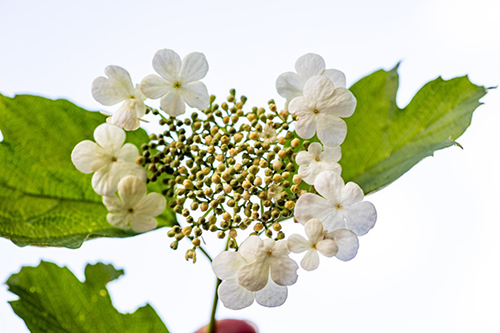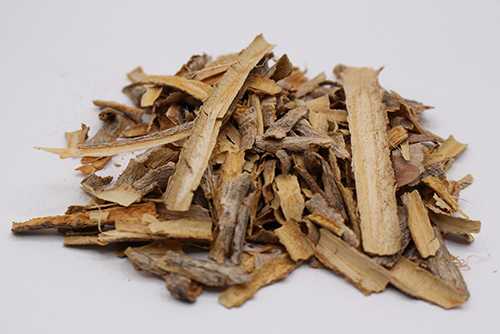Contents
Like other species of the genus Viburnum, cramp bark is an attractive shrub used as an ornamental plant in parks and gardens. However, be careful! Its striking red fruit is poisonous: it has a sour flavor that even birds do not eat. However, the bark of this plant has medicinal properties. It must not be mistaken with hawthorn, which also renders red fruit. Ancient botanists and physicians seldom used cramp bark. Now that we know its properties, it can be a helpful remedy when administered correctly.

Cramp Bark Scientific Facts
- Other names include Guelder rose and European cranberry.
- Scientific name – Viburnum opulus L.
- French – Viorne.
- Spanish – Bola de nieve.
- Environment – Common in woody, cold, humid regions all over Europe. It is also found in North America.
- Description—This shrub of the Caprifoliaceae family grows from two to four meters high. Its leaves are divided into three or five lobules with toothed borders. The white flowers gather in round bouquets, with the smallest in the center. The fruits are small red berries.
- Parts of the plant used medicinally – The bark, when dry.
Healing Properties

The bark of this plant contains coumarins and flavonoids, two substances to which its medicinal uses are attributed. It also contains tannin, salicin, resin, and small amounts of viburnum, a bitter component that is the causative agent of its toxic and irritant effects on the digestive tract. The fruits contain higher amounts of viburnum and are thus poisonous.
The bark of this shrub has antispasmodic and sedative properties on the female sexual organs. It relaxes the uterus muscle, calms the pain of the uterus, and calms the pain produced when this organ contracts with spasms. Cramp bark is one of the plant remedies that has the most intense action on the uterus. Perhaps its common name is derived from these effects. This plant is recommended for:

- Menstrual pain (dysmenorrhea) calms painful spasms of the uterus (womb) during menstruation.
- Abortion risk – Cramp bark herb relaxes the uterus when there is the risk of spontaneous abortion and can help avoid it. Cramp bark has not been proven to affect the fetus negatively; thus, pregnant women should not have any problem taking it.
- Hemorrhoids and varicose veins – This plant mildly activates venous blood flow (venotonic). It helps reduce the congestion of hemorrhoids and varicose veins, especially when combined with other venotonic plants.
Warning
All species of the genus Viburnum produce poisonous berry fruits. The fruit irritates the digestive tract and can cause gastroenteritis. In the case of poisoning, induce vomiting and administer charcoal.
American Viburnum Species
There are other plants of the genus Viburnum with similar appearance and properties to those of cramp bark.
- American viburnum (Viburnum prunifolium L.), which looks like a wayfaring tree, grows in North America, in the forests of Canada and the United States.
- Wayfaring tree (Viburnum lantana L.). This plant is spread throughout Europe. It differs from cramp bark in the shape of its leaves, which are opposed, ellipse-shaped, and fine-tipped. When ripe, its fruit is dark blue. Since they do not ripen simultaneously, you can find red, blue, and mixed-colored berries in the same cluster.
- Viburnum Tinus L. – This plant is common all over Europe. Its fruit is blue. Please don’t mistake it for bilberry.
How to use Cramp Bark
- Decoction with 30 grams of dry, ground bark per liter of water. Drink from three to five cups daily.
DISCLAIMER: All content on this website is presented solely for educational and informational objectives. Do not rely on the information provided as a replacement for advice, diagnosis, or treatment from a qualified medical expert. If you are pregnant, nursing, or have any preexisting medical concerns, talk to your doctor before using any herbal or natural medicines.
REFERENCES
- George D. Pamplona-Roger, M.D. “Encyclopedia of Medicinal Plants.” George D. Pamplona-Roger, M.D. Encyclopedia of Medicinal Plants. Ed. Francesc X. Gelabert. vols. 2 San Fernando de Henares: Editorial Safeliz, 2000. 642, 643. Print.
- https://www.rxlist.com/supplements/cramp_bark.htm
- https://www.healthline.com/nutrition/cramp-bark-guelder-rose
